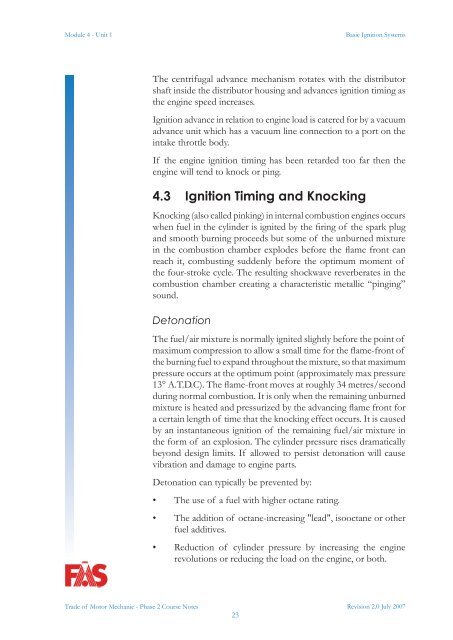Trade of Motor Mechanic - eCollege
Trade of Motor Mechanic - eCollege
Trade of Motor Mechanic - eCollege
You also want an ePaper? Increase the reach of your titles
YUMPU automatically turns print PDFs into web optimized ePapers that Google loves.
Module 4 - Unit 1 Basic Ignition Systems<br />
<strong>Trade</strong> <strong>of</strong> <strong>Motor</strong> <strong>Mechanic</strong> - Phase 2 Course Notes<br />
The centrifugal advance mechanism rotates with the distributor<br />
shaft inside the distributor housing and advances ignition timing as<br />
the engine speed increases.<br />
Ignition advance in relation to engine load is catered for by a vacuum<br />
advance unit which has a vacuum line connection to a port on the<br />
intake throttle body.<br />
If the engine ignition timing has been retarded too far then the<br />
engine will tend to knock or ping.<br />
4.3 Ignition Timing and Knocking<br />
Knocking (also called pinking) in internal combustion engines occurs<br />
when fuel in the cylinder is ignited by the firing <strong>of</strong> the spark plug<br />
and smooth burning proceeds but some <strong>of</strong> the unburned mixture<br />
in the combustion chamber explodes before the flame front can<br />
reach it, combusting suddenly before the optimum moment <strong>of</strong><br />
the four-stroke cycle. The resulting shockwave reverberates in the<br />
combustion chamber creating a characteristic metallic “pinging”<br />
sound.<br />
Detonation<br />
The fuel/air mixture is normally ignited slightly before the point <strong>of</strong><br />
maximum compression to allow a small time for the flame-front <strong>of</strong><br />
the burning fuel to expand throughout the mixture, so that maximum<br />
pressure occurs at the optimum point (approximately max pressure<br />
13° A.T.D.C). The flame-front moves at roughly 34 metres/second<br />
during normal combustion. It is only when the remaining unburned<br />
mixture is heated and pressurized by the advancing flame front for<br />
a certain length <strong>of</strong> time that the knocking effect occurs. It is caused<br />
by an instantaneous ignition <strong>of</strong> the remaining fuel/air mixture in<br />
the form <strong>of</strong> an explosion. The cylinder pressure rises dramatically<br />
beyond design limits. If allowed to persist detonation will cause<br />
vibration and damage to engine parts.<br />
Detonation can typically be prevented by:<br />
•<br />
•<br />
•<br />
The use <strong>of</strong> a fuel with higher octane rating.<br />
The addition <strong>of</strong> octane-increasing "lead", isooctane or other<br />
fuel additives.<br />
Reduction <strong>of</strong> cylinder pressure by increasing the engine<br />
revolutions or reducing the load on the engine, or both.<br />
2<br />
Revision 2.0 July 2007
















